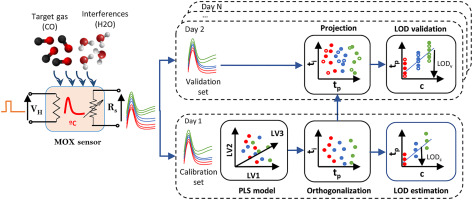当前位置:
X-MOL 学术
›
Anal. Chim. Acta
›
论文详情
Our official English website, www.x-mol.net, welcomes your
feedback! (Note: you will need to create a separate account there.)
Multivariate estimation of the limit of detection by orthogonal partial least squares in temperature-modulated MOX sensors
Analytica Chimica Acta ( IF 5.7 ) Pub Date : 2018-08-01 , DOI: 10.1016/j.aca.2018.03.005 Javier Burgués , Santiago Marco
Analytica Chimica Acta ( IF 5.7 ) Pub Date : 2018-08-01 , DOI: 10.1016/j.aca.2018.03.005 Javier Burgués , Santiago Marco

|
Metal oxide semiconductor (MOX) sensors are usually temperature-modulated and calibrated with multivariate models such as partial least squares (PLS) to increase the inherent low selectivity of this technology. The multivariate sensor response patterns exhibit heteroscedastic and correlated noise, which suggests that maximum likelihood methods should outperform PLS. One contribution of this paper is the comparison between PLS and maximum likelihood principal components regression (MLPCR) in MOX sensors. PLS is often criticized by the lack of interpretability when the model complexity increases beyond the chemical rank of the problem. This happens in MOX sensors due to cross-sensitivities to interferences, such as temperature or humidity and non-linearity. Additionally, the estimation of fundamental figures of merit, such as the limit of detection (LOD), is still not standardized in multivariate models. Orthogonalization methods, such as orthogonal projection to latent structures (O-PLS), have been successfully applied in other fields to reduce the complexity of PLS models. In this work, we propose a LOD estimation method based on applying the well-accepted univariate LOD formulas to the scores of the first component of an orthogonal PLS model. The resulting LOD is compared to the multivariate LOD range derived from error-propagation. The methodology is applied to data extracted from temperature-modulated MOX sensors (FIS SB-500-12 and Figaro TGS 3870-A04), aiming at the detection of low concentrations of carbon monoxide in the presence of uncontrolled humidity (chemical noise). We found that PLS models were simpler and more accurate than MLPCR models. Average LOD values of 0.79 ppm (FIS) and 1.06 ppm (Figaro) were found using the approach described in this paper. These values were contained within the LOD ranges obtained with the error-propagation approach. The mean LOD increased to 1.13 ppm (FIS) and 1.59 ppm (Figaro) when considering validation samples collected two weeks after calibration, which represents a 43% and 46% degradation, respectively. The orthogonal score-plot was a very convenient tool to visualize MOX sensor data and to validate the LOD estimates.
中文翻译:

温度调制 MOX 传感器中正交偏最小二乘法检测极限的多变量估计
金属氧化物半导体 (MOX) 传感器通常使用偏最小二乘法 (PLS) 等多元模型进行温度调制和校准,以增加该技术固有的低选择性。多元传感器响应模式表现出异方差和相关噪声,这表明最大似然方法应该优于 PLS。本文的一个贡献是 MOX 传感器中 PLS 和最大似然主成分回归 (MLPCR) 之间的比较。当模型复杂性增加到超出问题的化学等级时,PLS 经常因缺乏可解释性而受到批评。由于对干扰(例如温度或湿度和非线性)的交叉敏感性,在 MOX 传感器中会发生这种情况。此外,基本品质因数的估计,例如检测限 (LOD),在多变量模型中仍未标准化。正交化方法,例如正交投影到潜在结构(O-PLS),已成功应用于其他领域,以降低 PLS 模型的复杂性。在这项工作中,我们提出了一种 LOD 估计方法,该方法基于将广为接受的单变量 LOD 公式应用于正交 PLS 模型的第一个组件的分数。将得到的 LOD 与从误差传播得出的多变量 LOD 范围进行比较。该方法应用于从温度调制 MOX 传感器(FIS SB-500-12 和 Figaro TGS 3870-A04)中提取的数据,旨在检测存在不受控制的湿度(化学噪声)的低浓度一氧化碳。我们发现 PLS 模型比 MLPCR 模型更简单、更准确。使用本文中描述的方法发现了 0.79 ppm (FIS) 和 1.06 ppm (Figaro) 的平均 LOD 值。这些值包含在使用误差传播方法获得的 LOD 范围内。考虑到校准后两周收集的验证样品,平均 LOD 增加到 1.13 ppm (FIS) 和 1.59 ppm (Figaro),分别代表 43% 和 46% 的降解。正交得分图是一种非常方便的工具,可用于可视化 MOX 传感器数据并验证 LOD 估计值。考虑校准后两周收集的验证样品时为 59 ppm (Figaro),分别代表 43% 和 46% 的降解。正交得分图是一种非常方便的工具,可用于可视化 MOX 传感器数据并验证 LOD 估计值。考虑校准后两周收集的验证样品时为 59 ppm (Figaro),分别代表 43% 和 46% 的降解。正交得分图是一种非常方便的工具,可用于可视化 MOX 传感器数据并验证 LOD 估计值。
更新日期:2018-08-01
中文翻译:

温度调制 MOX 传感器中正交偏最小二乘法检测极限的多变量估计
金属氧化物半导体 (MOX) 传感器通常使用偏最小二乘法 (PLS) 等多元模型进行温度调制和校准,以增加该技术固有的低选择性。多元传感器响应模式表现出异方差和相关噪声,这表明最大似然方法应该优于 PLS。本文的一个贡献是 MOX 传感器中 PLS 和最大似然主成分回归 (MLPCR) 之间的比较。当模型复杂性增加到超出问题的化学等级时,PLS 经常因缺乏可解释性而受到批评。由于对干扰(例如温度或湿度和非线性)的交叉敏感性,在 MOX 传感器中会发生这种情况。此外,基本品质因数的估计,例如检测限 (LOD),在多变量模型中仍未标准化。正交化方法,例如正交投影到潜在结构(O-PLS),已成功应用于其他领域,以降低 PLS 模型的复杂性。在这项工作中,我们提出了一种 LOD 估计方法,该方法基于将广为接受的单变量 LOD 公式应用于正交 PLS 模型的第一个组件的分数。将得到的 LOD 与从误差传播得出的多变量 LOD 范围进行比较。该方法应用于从温度调制 MOX 传感器(FIS SB-500-12 和 Figaro TGS 3870-A04)中提取的数据,旨在检测存在不受控制的湿度(化学噪声)的低浓度一氧化碳。我们发现 PLS 模型比 MLPCR 模型更简单、更准确。使用本文中描述的方法发现了 0.79 ppm (FIS) 和 1.06 ppm (Figaro) 的平均 LOD 值。这些值包含在使用误差传播方法获得的 LOD 范围内。考虑到校准后两周收集的验证样品,平均 LOD 增加到 1.13 ppm (FIS) 和 1.59 ppm (Figaro),分别代表 43% 和 46% 的降解。正交得分图是一种非常方便的工具,可用于可视化 MOX 传感器数据并验证 LOD 估计值。考虑校准后两周收集的验证样品时为 59 ppm (Figaro),分别代表 43% 和 46% 的降解。正交得分图是一种非常方便的工具,可用于可视化 MOX 传感器数据并验证 LOD 估计值。考虑校准后两周收集的验证样品时为 59 ppm (Figaro),分别代表 43% 和 46% 的降解。正交得分图是一种非常方便的工具,可用于可视化 MOX 传感器数据并验证 LOD 估计值。











































 京公网安备 11010802027423号
京公网安备 11010802027423号